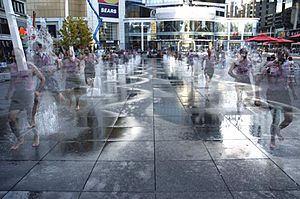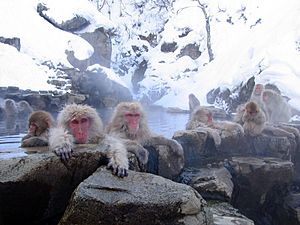Bathing facts for kids

Bathing means putting your body into a liquid, usually water. People bathe for many reasons. Most often, it's for hygiene (to get clean) or for fun. Sometimes, bathing is also part of a religious practice or used as a type of therapy to help you feel better.
When we talk about bathing, we usually think of being in water. But people have also "bathed" in other things! For example, some therapies involve bathing in mud. People have even bathed in things like Champagne, beans, or chocolate for fun or special events. Another common type of "bathing" is simply relaxing in the sunlight.
Contents
Why Do People Bathe?

Bathing serves many different purposes for people around the world:
Staying Clean and Healthy
- Hygiene: This is the most common reason. Bathing helps you clean your body and look neat. It removes dirt, sweat, and germs, keeping you healthy.
- Decontamination: Sometimes, bathing is needed to wash off harmful substances. This could be after being exposed to certain chemicals or other dangerous materials.
Fun and Relaxation
- Recreation: Bathing can be a lot of fun! Think about swimming in a pool or playing in a splash pad on a hot day.
- Therapy and Relaxation: Taking a warm bath can be very relaxing. It can help you calm down after a busy day. Some types of bathing, like hydrotherapy, use water to help heal injuries or make you feel better.
Special Occasions and Traditions
- Religious or Ceremonial Reasons: For some people, bathing is an important part of their religion. For example, Baptism is a religious ceremony that involves water.
- Celebrations: People might jump into water as part of a celebration. This could be running through fountains after a big win, or even jumping into a cold lake on New Year's Eve as a fun tradition.
- Safety and Entry: In some places, like homeless shelters or prisons, people might take a supervised shower when they first arrive. This helps make sure everyone is clean and doesn't bring anything dangerous into the facility.
Images for kids
-
Inside a public wash house in Liverpool, England, from 1914. This was the first public wash house in England.
-
The timba (pail) and the tabo (dipper), two important tools for bathing in the Philippines.
See also
 In Spanish: Baño para niños
In Spanish: Baño para niños








